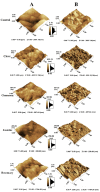Back to Nature: Combating Candida albicans Biofilm, Phospholipase and Hemolysin Using Plant Essential Oils
- PMID: 33467766
- PMCID: PMC7830859
- DOI: 10.3390/antibiotics10010081
Back to Nature: Combating Candida albicans Biofilm, Phospholipase and Hemolysin Using Plant Essential Oils
Abstract
Candida albicans is the causative agent of fatal systemic candidiasis. Due to limitations of antifungals, new drugs are needed. The anti-virulence effect of plant essential oils (EOs) was evaluated against clinical C. albicans isolates including cinnamon, clove, jasmine and rosemary oils. Biofilm, phospholipase and hemolysin were assessed phenotypically. EOs were evaluated for their anti-virulence activity using phenotypic methods as well as scanning electron microscopy (SEM) and atomic force microscopy (AFM). Among the C. albicans isolates, biofilm, phospholipase and hemolysins were detected in 40.4, 86.5 and 78.8% of isolates, respectively. Jasmine oil showed the highest anti-biofilm activity followed by cinnamon, clove and rosemary oils. SEM and AFM analysis showed reduced adherence and roughness in the presence of EOs. For phospholipase, rosemary oil was the most inhibitory, followed by jasmine, cinnamon and clove oils, and for hemolysins, cinnamon had the highest inhibition followed by jasmine, rosemary and clove oils. A molecular docking study revealed major EO constituents as promising inhibitors of the Als3 adhesive protein, with the highest binding for eugenol, followed by 1,8-cineole, 2-phenylthiolane and cinnamaldehyde. In conclusion, EOs have a promising inhibitory impact on Candida biofilm, phospholipase and hemolysin production, hence EOs could be used as potential antifungals that impact virulence factors.
Keywords: AFM; Candida albicans; SEM; biofilm; essential oils; hemolysin; jasmine oil; molecular docking; phospholipase.
Conflict of interest statement
The authors declare no conflict of interest.
Figures






Similar articles
-
Cinnamon Leaf and Clove Essential Oils Are Potent Inhibitors of Candida albicans Virulence Traits.Microorganisms. 2022 Oct 8;10(10):1989. doi: 10.3390/microorganisms10101989. Microorganisms. 2022. PMID: 36296264 Free PMC article.
-
Antifungal and anti-virulence activity of six essential oils against important Candida species - a preliminary study.Future Microbiol. 2022 Jul;17:737-753. doi: 10.2217/fmb-2021-0296. Epub 2022 May 9. Future Microbiol. 2022. PMID: 35531749
-
Effects of patchouli and cinnamon essential oils on biofilm and hyphae formation by Candida species.J Mycol Med. 2018 Jun;28(2):332-339. doi: 10.1016/j.mycmed.2018.02.012. Epub 2018 Mar 20. J Mycol Med. 2018. PMID: 29571979
-
Anti-biofilm effect of clove oil against Candida albicans: A systematic review.J Oral Maxillofac Pathol. 2024 Oct-Dec;28(4):665-671. doi: 10.4103/jomfp.jomfp_225_24. Epub 2024 Dec 31. J Oral Maxillofac Pathol. 2024. PMID: 39949693 Free PMC article. Review.
-
Therapeutic Effects of Essential Oils and Their Bioactive Compounds on Prostate Cancer Treatment.Pharmaceutics. 2024 Apr 24;16(5):583. doi: 10.3390/pharmaceutics16050583. Pharmaceutics. 2024. PMID: 38794244 Free PMC article. Review.
Cited by
-
Anti-Candidal Activity of Reboxetine and Sertraline Antidepressants: Effects on Pre-Formed Biofilms.Antibiotics (Basel). 2023 May 9;12(5):881. doi: 10.3390/antibiotics12050881. Antibiotics (Basel). 2023. PMID: 37237784 Free PMC article.
-
Lipid nanocarrier containing eugenol for denture hygiene: evaluation of efficacy against Candida biofilms.J Appl Oral Sci. 2025 Mar 10;33:e20240455. doi: 10.1590/1678-7757-2024-0455. eCollection 2025. J Appl Oral Sci. 2025. PMID: 40073014 Free PMC article.
-
Essential Oils for Biofilm Control: Mechanisms, Synergies, and Translational Challenges in the Era of Antimicrobial Resistance.Antibiotics (Basel). 2025 May 13;14(5):503. doi: 10.3390/antibiotics14050503. Antibiotics (Basel). 2025. PMID: 40426569 Free PMC article. Review.
-
Cinnamon Leaf and Clove Essential Oils Are Potent Inhibitors of Candida albicans Virulence Traits.Microorganisms. 2022 Oct 8;10(10):1989. doi: 10.3390/microorganisms10101989. Microorganisms. 2022. PMID: 36296264 Free PMC article.
-
Impact of Clove Essential Oil on the Intestinal Flora in Mice Infected with Candida albicans.Molecules. 2025 May 29;30(11):2372. doi: 10.3390/molecules30112372. Molecules. 2025. PMID: 40509258 Free PMC article.
References
-
- Andes D.R., Safdar N., Baddley J.W., Playford G., Reboli A.C., Rex J.H., Sobel J.D., Pappas P.G., Kullberg B.J. Impact of treatment strategy on outcomes in patients with candidemia and other forms of invasive candidiasis: A patient-level quantitative review of randomized trials. Clin. Infect. Dis. 2012;54:1110–1122. doi: 10.1093/cid/cis021. - DOI - PubMed
LinkOut - more resources
Full Text Sources
Other Literature Sources
Miscellaneous

